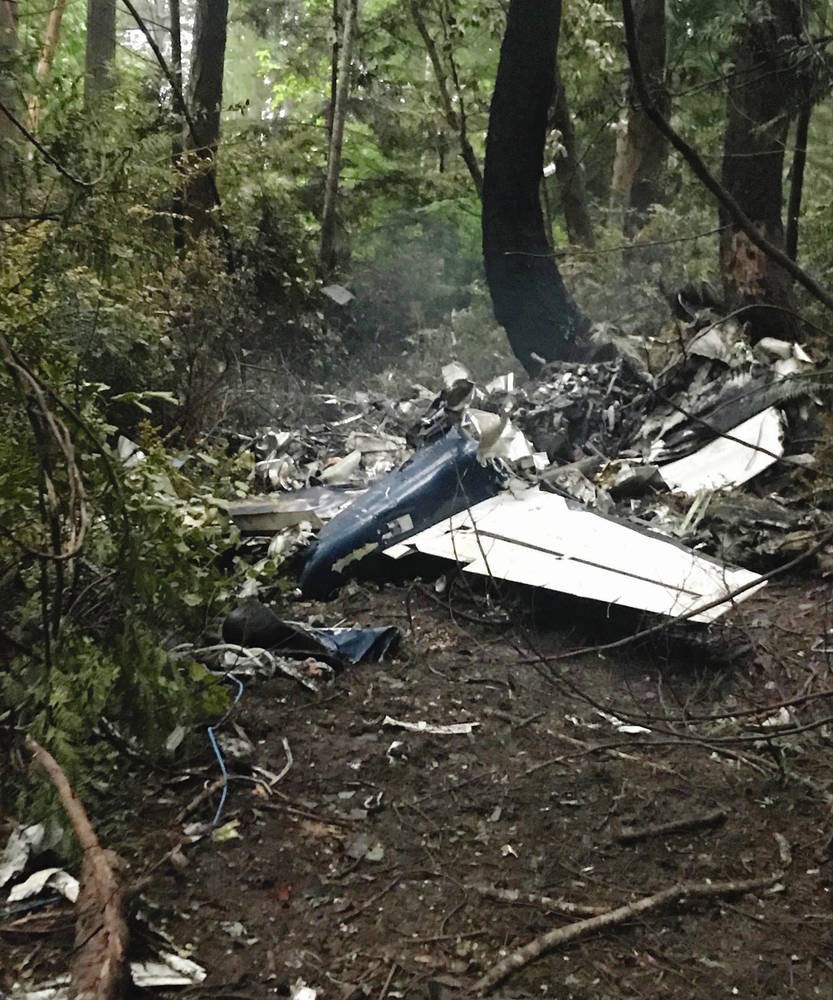Massive blunt force trauma was the cause of death for three people who died after instrument failure and weather conditions contributed to a small twin-engine plane crashing into Gabriola Island in the winter of 2019, says a B.C. Coroners Service report.
On Dec. 10, 2019, a small private twin-engine propeller Piper Aerostar crashed in a wooded area on the northwest corner of Gabriola, east of Nanaimo, killing the plane’s owner Hermann Alexander Bahlsen, 62, of Mill Bay, as well as Ladysmith residents Allan Edward Boudreau and Margaret Katheryn Boudreau, both 53.
“An autopsy was not required as the cause of death was obvious on examination,” said coroner Lyn Blenkinsop, in a report completed in October and released by the B.C. Coroners Service this week. It’s the final report, on the heels of one by the Transportation Safety Board in July.
Bahlsen was the heir to the Bahlsen biscuit empire in Germany, and the Boudreaus were former owners of a vegetable growing business, Island Hothouse in Saltair.
The six-seater plane was approaching Nanaimo Airport when it crashed following a two-day journey from Cabo San Lucas to Nanaimo, with an overnight stop in California.
“The TSB was unable to determine which of the pilots was flying the aircraft,” said the coroner’s report.
Both men on the plane were certified pilots and sitting in the cockpit; Boudreau on the left which is the traditional pilot’s seat, and Bahlsen in the right seat normally considered the co-pilot’s.
Bahlsen held a commercial pilot’s licence for planes, helicopters and gliders, and a pilot permit for ultralight planes. He had more than 13,000 hours of flight time. He was also an experienced flight instructor. Boudreau had a private pilot licence for single-engine aircraft and seaplanes with 320 hours of total flight time. He did not have a rating for — or recorded hours of — flying by instrument flight rules.
The plane was certified to be flown by instrument flight rules, which allows a pilot to operate in any weather conditions, as well as visual flight rules, for clear weather that allows use of visual clues. The plane was equipped with a horizontal situation indicator (HSI) which worked with a global positioning system and autopilot.
The Transportation Safety Board investigation found the HSI instrument had failed on both Nov. 22 and Nov. 26, weeks prior to the crash, and was booked for maintenance. It was destroyed in the crash and couldn’t be examined, said the coroner’s report. Other flight equipment was also too damaged for the safety board to determine its serviceability.
The plane departed on its final leg from Bishop Airport in California at 2:25 p.m on Dec. 10, 2019.
At 5:41 p.m. a meteorological report issued for Nanaimo advised of light drizzle and mist and an overcast ceiling of 400 feet above ground and the pilot informed the air controller that he would be conducting an instrument landing. At 5:49 p.m. the pilot asked air traffic controllers about weather conditions at Victoria International Airport.
At 6:03 the pilot told the air traffic controller he had an instrument failure.
In the final minute before air traffic control lost contact with the plane, the aircraft was losing and gaining altitude, climbing right, and the pilot reported the failure of the attitude indicator, an instrument also called an artificial horizon, which shows the pitch and roll and general orientation of the plane relative to the horizon and ground.
At 6:05 p.m. the plane was travelling at 300 feet and 120 knots.
“Control of the aircraft was lost,” said the coroner’s report. The plane collided with a power pole and trees in a wooded park, hit the ground, caught fire and broke into pieces.
All three occupants were dead at the scene.
Pilots are trained on how to regain situational awareness but it’s a difficult task that was made more difficult, according to the coroner’s report, due to poor visibility and instrument failure that resulted in a lack of internal and external visual cues.
The coroner’s report cited the TSB report, which said “pilots who experience high cognitive workloads can be vulnerable to perceptual bias which makes them vulnerable to spatial disorientation.”
The TSB report said aircraft owners must ensure that “aircraft deficiencies are recorded and rectified before flight.”
Toxicology testing was negative for prescribed medications or illicit drugs for Bahlsen and the Boudreaus.


